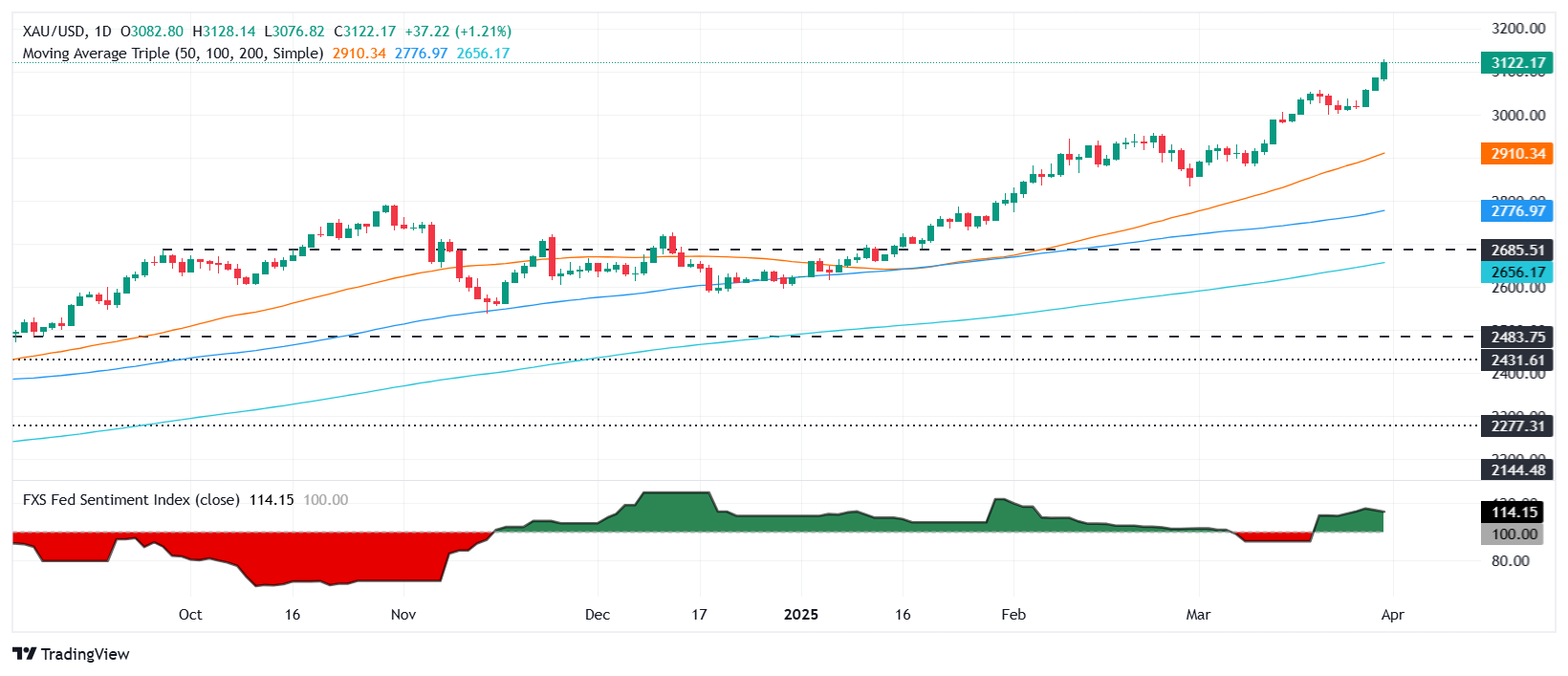Gold price blasts through $3,100 as trade war fears ignite safe-haven rush
- Gold hits fresh all-time high amid speculation Trump’s April 2 tariffs could target all trade partners.
- Goldman ups US recession odds to 35% as sentiment deteriorates and Washington signals tolerance for slowdown.
- DXY and yields rise but fail to dent Gold’s rally as safe-haven flows dominate ahead of key US data.
Gold prints another record high on Monday, surpassing the $3,100 threshold for the first time and extends its gains to an all-time high of $3,127 before retreating somewhat. Uncertainty surrounding US trade policies and the April 2 Liberation Day is lingering, with investors shifting risk-averse and flocking to the yellow metal’s safe-haven appeal. At the time of writing, XAU/USD trades at $3,119, up more than 1%.
Risk appetite deteriorates as traders await the announcement of additional tariffs on Wednesday. Goldman Sachs revealed that the odds of a recession in the United States (US) rose from 20% to 35%, primarily due to business and household pessimism about the outlook, as well as Washington's tolerance of a deeper economic slowdown.
Trump’s comments on Sunday on Air Force One increased the chances that tariffs could be universal, instead of the 10 or 15 revealed by US Treasury Secretary Scott Bessent. “Who told you 10 or 15? You might have heard it, but you didn’t hear it from me,” the President said. “You’d start with all countries. So let’s see what happens.”
Therefore, Bullion prices exploded, even though US Treasury bond yields had recovered some ground, particularly the coupon of the 10-year T-note. The US Dollar Index (DXY), which tracks the value of the buck against a basket of six currencies, climbs 0.24% to 104.25.
On the data front, the Chicago PMI improved, despite remaining in contractionary territory for the sixteenth straight month. Ahead this week, the US economic docket will feature the ISM Manufacturing and Services PMI, as well as Nonfarm Payrolls figures.
Daily digest market movers: Gold prices rises amid firm US Treasury yields
- The US 10-year T-note yield is flat at 4.257%. US real yields edge down two bps to 1.86%, according to US 10-year Treasury Inflation-Protected Securities (TIPS) yields.
- The Chicago PMI data for March rose by 47.6 points from 45.5 and exceeded forecasts of 45.2. Notably, it is the largest level since November 2023, yet it remains in contractionary territory for the sixteenth consecutive month.
- Some of the subcomponents improved, like Production, New Orders, Employment, and Order Backlogs. Supplier Deliveries, Inventories and Prices Paid dipped, according to the poll.
- Last week’s US inflation data held steady, according to the US Bureau of Economic Analysis. Nevertheless, the risks of a recession drove market participants to price in over 74 basis points of easing toward the end of 2025, according to data from the Chicago Board of Trade.
- In the geopolitics space, US President Donald Trump threatened to impose secondary tariffs of 25%-50% on buyers of Russian oil, if Moscow blocks his efforts to end the war in Ukraine.
- Wall Street’s banks had updated their Gold forecasts last week. Economists at Goldman Sachs, Société Générale, and Bank of America identified $3,300 as the next target, according to a Kitco article.
XAU/USD technical outlook: Gold price rallies past $3,050, eyes on $3,100

Gold’s rally expands. The yellow metal is up 18.96% so far this year, and due to uncertainty in the financial markets, the uptrend could continue. Although the Relative Strength Index (RSI) is overbought, traders should be aware that, due to the aggressiveness of the move, the most extreme level is 80.
The XAU/USD’s next resistance would be the psychological $3,150 and $3,200 on the upside. On the other hand, Bullion’s first support would be $3,100. A breach of the latter will expose the March 20 high turned support at $3,057, followed by the $3,000 figure.
Gold FAQs
Gold has played a key role in human’s history as it has been widely used as a store of value and medium of exchange. Currently, apart from its shine and usage for jewelry, the precious metal is widely seen as a safe-haven asset, meaning that it is considered a good investment during turbulent times. Gold is also widely seen as a hedge against inflation and against depreciating currencies as it doesn’t rely on any specific issuer or government.
Central banks are the biggest Gold holders. In their aim to support their currencies in turbulent times, central banks tend to diversify their reserves and buy Gold to improve the perceived strength of the economy and the currency. High Gold reserves can be a source of trust for a country’s solvency. Central banks added 1,136 tonnes of Gold worth around $70 billion to their reserves in 2022, according to data from the World Gold Council. This is the highest yearly purchase since records began. Central banks from emerging economies such as China, India and Turkey are quickly increasing their Gold reserves.
Gold has an inverse correlation with the US Dollar and US Treasuries, which are both major reserve and safe-haven assets. When the Dollar depreciates, Gold tends to rise, enabling investors and central banks to diversify their assets in turbulent times. Gold is also inversely correlated with risk assets. A rally in the stock market tends to weaken Gold price, while sell-offs in riskier markets tend to favor the precious metal.
The price can move due to a wide range of factors. Geopolitical instability or fears of a deep recession can quickly make Gold price escalate due to its safe-haven status. As a yield-less asset, Gold tends to rise with lower interest rates, while higher cost of money usually weighs down on the yellow metal. Still, most moves depend on how the US Dollar (USD) behaves as the asset is priced in dollars (XAU/USD). A strong Dollar tends to keep the price of Gold controlled, whereas a weaker Dollar is likely to push Gold prices up.

